The problem with Pride Flags, I realised this week, is that apart from the blindingly obvious Rainbow Flag, very few of them are recognised outside of their specific communities.
The reason this became apparent to me is because I’ve recently bought a couple of colourful face-masks. I figure if I have to wear them, they might as well be bright, funky, and make a point. A bit like I do with my toenails, but even more so. And I was feeling vaguely more comfortable with my self-image than I usually am (there’ll be more about this in a subsequent post, to be written one day), so I posted a selfie onto Instagram Stories.
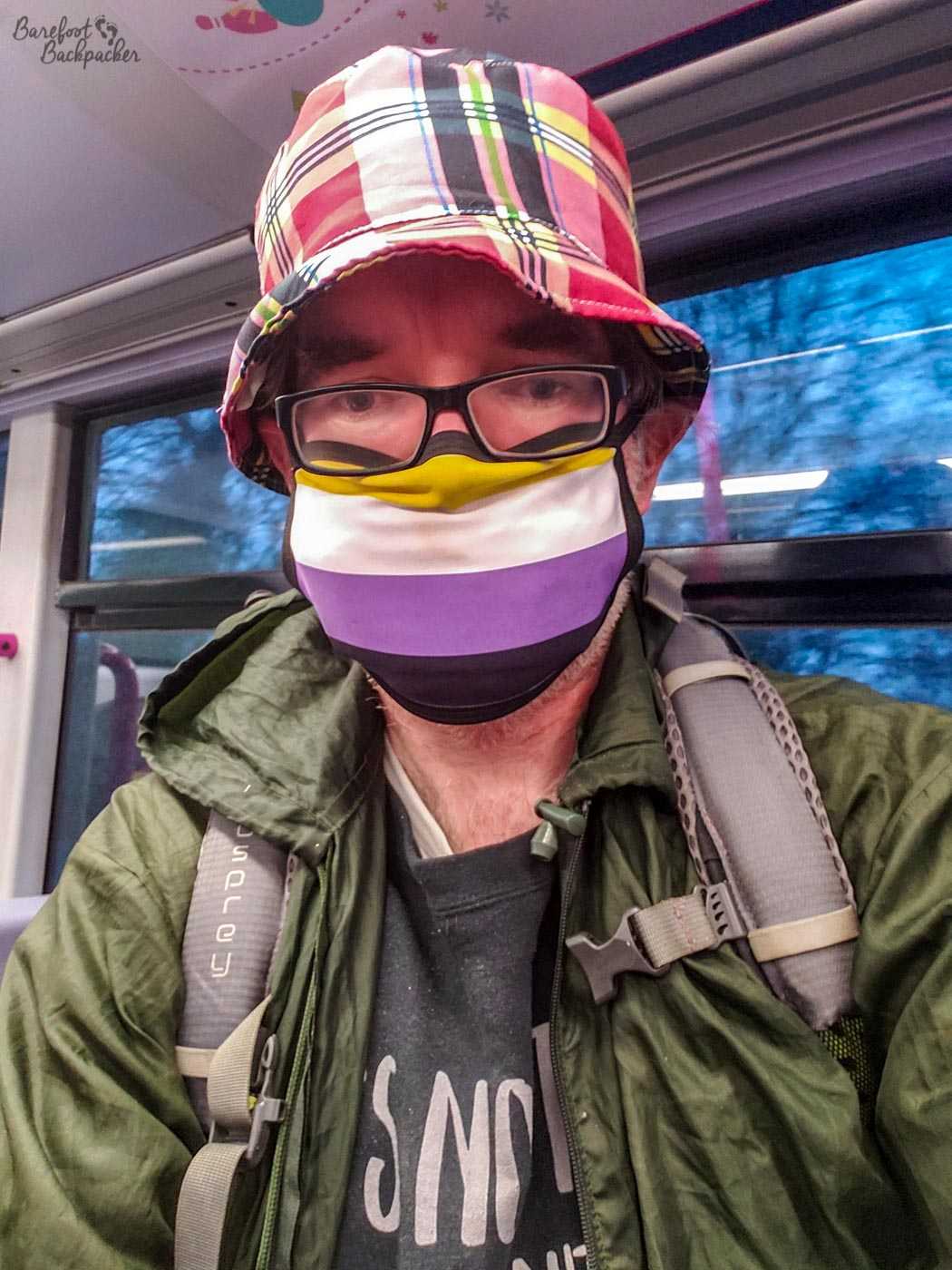
This was the selfie in question, taken on a tram in Sheffield while I was food/beer shopping.
I then posted a follow-up poll. I left the wording of the question deliberately vague, and made sure I didn’t ask ‘do you know what these colours mean’, as I didn’t want people to do research. Instead I asked this: ‘if you saw these colours in this order in the street somewhere, would you think they meant something specific/significant without checking on the off-chance, or would you just think ‘cool colours’?’. The results were interesting: 51% of respondents said ‘I just think they’re cool’, 49% said ‘I think they’re significant’.
I spoke a bit in a previous post about how being asexual sometimes feels quite odd, especially when I travel, because it’s almost as if I’m ‘hiding in plain sight’. I have both an asexual pride face-mask and two asexual-themed sweatshirts, and apart from the occasional side-comment relating to the snarky messages rather than the sentiment, almost nobody has ever picked up on the asexual theme.

Shopping in full asexual regalia. No-one noticed.
This got me thinking a bit. As you already know, I’m quite keen on boosting Asexual (and Aromantic) representation, because there’s not a lot of it, but it’s quite hard if no-one knows what to look out for in the first place, if no-one recognises the symbols. And it appears to be the same issue for many of the other orientations in the LGBTQIA+ acronym – while it’s ‘safe’ to openly wear a Pride Flag that no-one else recognises, it’s better in the long term if we’re more visible. Gaining rep, making people realise a) we’re here and we’re queer (so to speak), and b) showing people that there’s nothing scary about us and in fact ‘we are just like you’ will encourage more people to start to look at their own identities in order to find out who they feel happiest as.
Disclaimer: your identity is valid, whatever it is, and it’s not for me to tell you what that identity is. Only you can do that, based on your own feelings and thoughts. There’s no such thing as A One Twue Representative of any identity. In addition, you don’t have to claim one at all. It’s perfectly valid to be straight; indeed regardless of representation, regardless of pride, being ‘straight’ will always be the majority, the most common and default option. All we’re doing is showing you all the other options. Like a doughnut shop. If you know you like plain jam, seeing 20 different flavours and designs won’t change what you are and what you like.
As a result of that poll, I then had the idea to post a series of Instagram Stories with an overview of many different other orientations and identities, with a visualisation of their flags. I also provided a, shall we say, somewhat snarky description of the flag, to help people remember it better. Apologies if your flag isn’t represented; with so many identities I could only select a few that jumped out at me.
So, without further ado: Barefoot Backpacker’s Guide To Pride Flags. And if you only take one thing out of this exercise, it’s this: we’re awfully fond of stripes.
Asexuality Pride
Definition: the lack of sexual attraction to others. Many asexuals have a low (or absent) interest in sexual desire or activity, but that doesn’t mean that asexuals don’t have sex (you’re thinking of celibacy, a very different thing). Nor does it mean they don’t like sex. It just means they’re not going to look at you and go ‘I want to bonk that’. It is the ‘A’ in LGBTQIA+.
Flag:
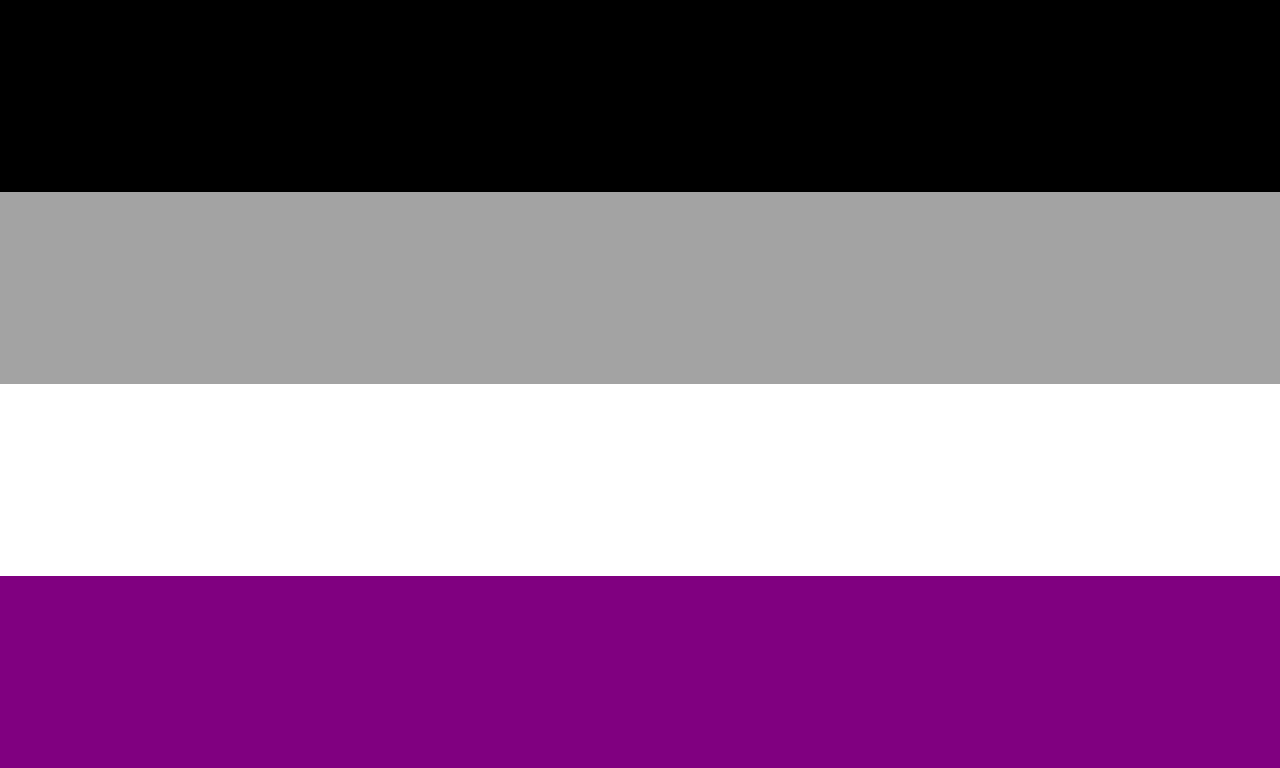
Flag Notes: You had ten minutes to complete your flag design homework, and only had two felt-tip pens or sharpies. One of which is running out.
I’ve spoken about this flag before!
Representatives: Activist and Model Yasmin Benoit, Indian actress Sriti Jha, and, arguably, former British Prime Minister Edward Heath (his official biographer states such).
Aromantic Pride
Definition: the lack of romantic attraction to others. Aromantic (often shortened to aro) people don’t meet people and go ‘I’m in (romantic) love with you’. Quite what romantic attraction is, is something long debated into the small hours, and is often considered relative and subjective, but aromantics aren’t the sort of people for whom the traditional ideas around romantic activities, dates, or possibly even public displays of affection, has any kind of thrill or appeal. It is also the ‘A’ in LGBTQIA+.
Flag:
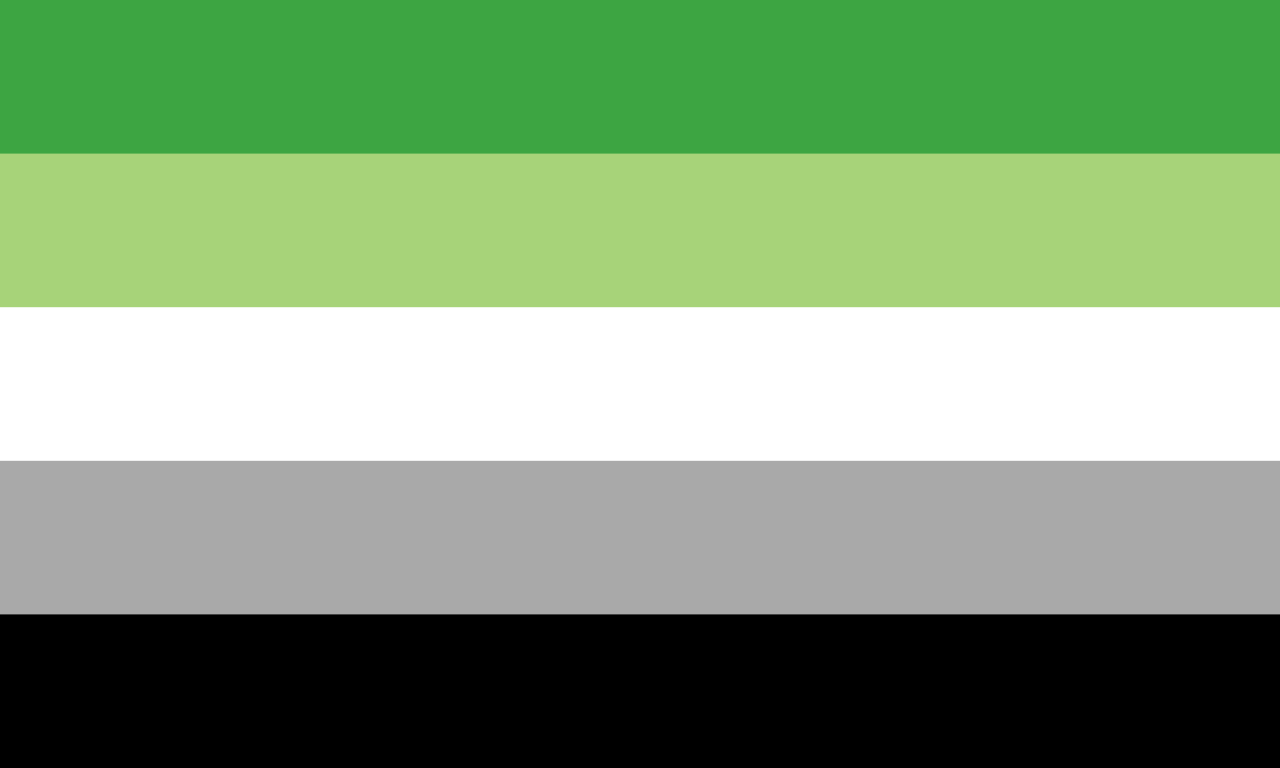
Flag Notes: Someone’s favourite colour was green, and wanted to create a flag promoting many shades. Unfortunately they accidentally switched to monochrome mode partway through design.
Representatives: … very few who aren’t also asexual. Suggestions have been made for historical persons like scientist Nikola Tesla, but of course that’s “queerclaiming” (as defined by ‘Soup’ on the Sounds Fake But Okay Discord Server). People also have suggested Sherlock Holmes and Katniss Everdeen as potentially aromantic.
Bisexual Pride
Definition: Ah, y’all know this – it’s the ‘B’ in LGBTQIA+. Bisexual (or ‘bi’) means someone who is sexually (and probably romantically, but that’s a whole different ball-game) attracted to people of two or more genders, usually specifically both the same gender and different genders to their own. Many people seem to have the belief it means ‘attraction to men and women’, or ‘attraction to two genders’, but this isn’t necessarily the case at all.
Flag:

Flag Notes: ‘Wash Dark Colours Separately’ exists for a reason.
Also, the following conversation
– “Not enough stripes.”
– “Ah, too late, I’ve just finished painting it.”
– “Well, the paint’s still wet; can you do a little blending? Just on a small section, to see how it looks”
Representatives: Actress and filmmaker Kristen Stewart, singer Billie Joe Armstrong, and the person largely seen as holding the fabric of time and space together, David Bowie. And possibly Freddie Mercury.
Pansexual Pride
Definition: the (sexual, etc) attraction to people regardless of their gender – thus being attracted to all genders. This doesn’t necessarily mean that gender is important to or influences their attraction, just that their experience of attraction can encompass all genders. The difference between Bisexuality, Pansexuality, Omnisexuality (not a good flag), and Polysexuality is a discussion far beyond the scope of this article.
Flag:

Flag Notes: Primary colours. On acid.
This is actually my favourite of all the Pride flags.
Representatives: Musician and actress Miley Cyrus, comedian Joe Lycett, and politicans Mary González (Texas) and Layla Moran (UK).
Transgender Pride
Definition: the ‘T’ in LGBTQIA+ (and some of the pills!) – this is a word used to describe people who don’t identify or align with the gender assigned to them at birth. In the most part this is pretty simple; trans women (note the space, it’s grammatically important, you wouldn’t write ‘greenapple’) are women who were assigned as male at birth, and trans men are men who were assigned female at birth. How far along the road to full transition they are is not important.
It gets messier when you consider non-binary people, who technically fall under this banner (one reason LGBTQIA+ doesn’t have an ‘N’ in it) as their assigned gender at birth is different to their gender identity, but many non-binary people don’t consider themselves Trans.
Flag:
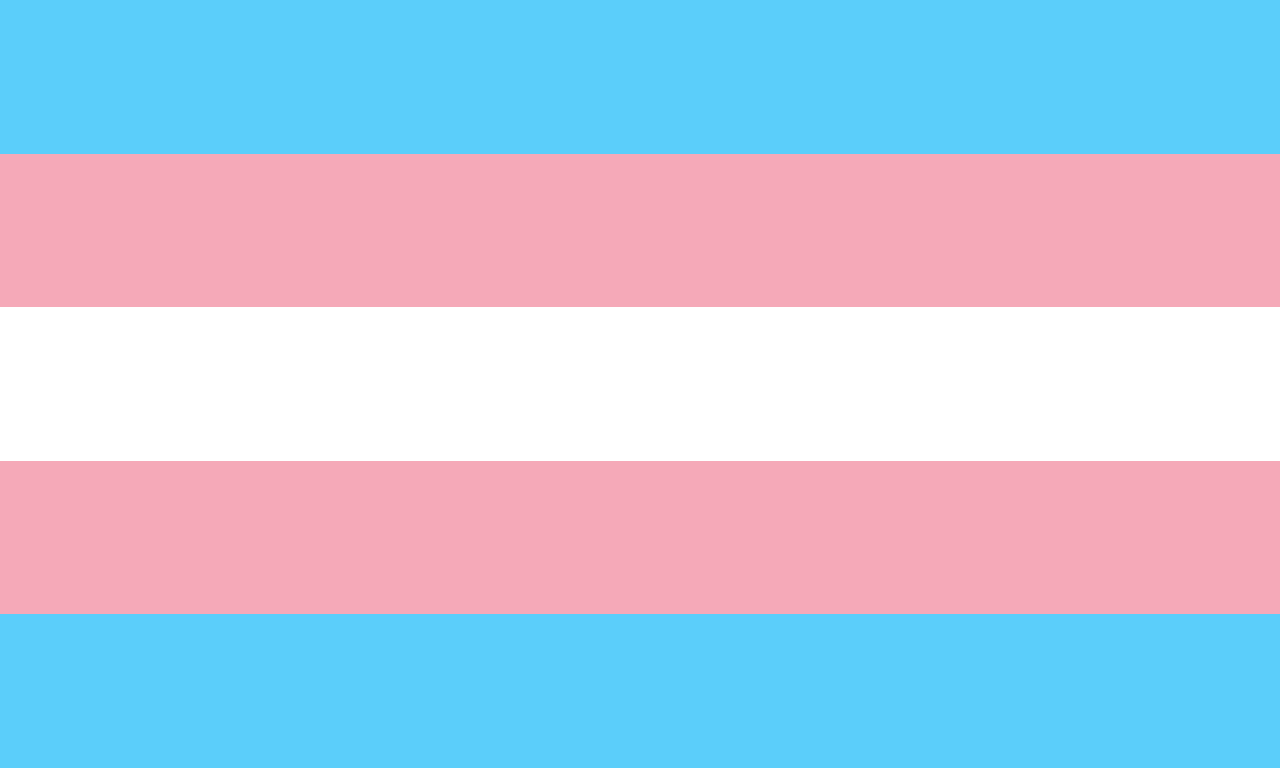
Flag Notes: Blue Is For Boys, Pink Is For Girls. Repeat until you run out of flag.
Representatives: Many. Let’s go with travel writer and historian (not me!) Jan Morris, comedian and actor Ian Harvie, and deputy Prime Minister of Belgium Petra De Sutter.
GenderFluid Pride
Definition: someone whose gender identity is not fixed, but rather fluctuates and changes over time. This time period can be long-term and gradual, regular like the seasons, or it could be sudden and immediate and based on environmental or social changes. The fluidity is not limited to the gender binary either; they can (and will) identify as any gender at any time, including no gender. Think of it like they wear their gender like they wear their t-shirt collection.
There is a bit of an overlap with Pansexuality, which makes inherent sense.
Flag:
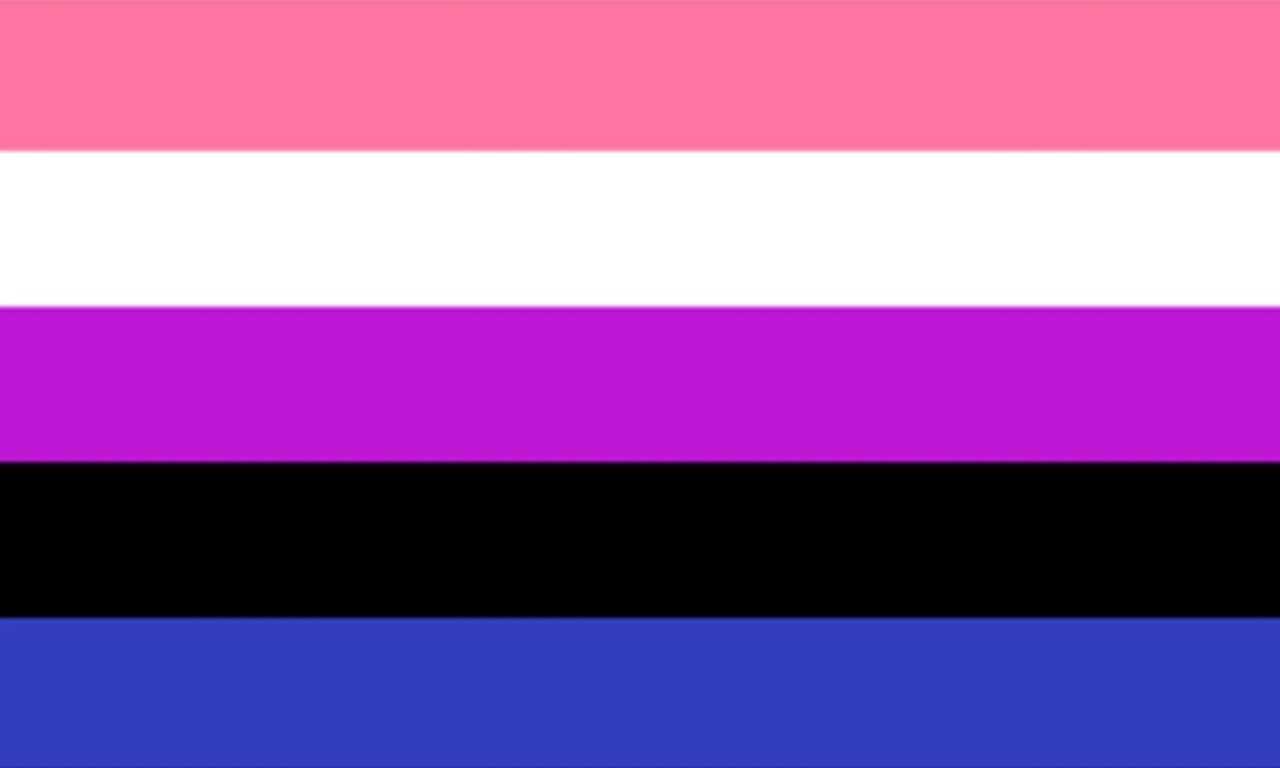
Flag Notes: You were tasked to create a flag different to the Transgender and GenderQueer flags. Unfortunately you accidentally spilled some black paint over the bottom half. You saved what you could but the damage was already done.
Representatives: comedian Eddie Izzard (of course), actress Cara Delevingne, and powerlifter/bodybuilder Janae Kroc.
GenderQueer Pride
Definition: my research has concluded this is the vaguest of all the identities. It’s used by people who define themselves as, effectively, ‘not fitting’ into the usual concepts of gender and gender identity. This could be direct – people who fall into the transgender or non-binary umbrellas could describe themselves thus – or indirect, where someone’s outward gender presentation doesn’t match their assigned gender, even if they themselves are comfortable being their assigned gender.
Some people also define themselves as GenderQueer if none of the other identities quite match how they feel about themselves, but still know they’re not constrainable by the gender binary. By inference, it may also be used as a socio-political statement – sort of like “I’m different, respect me”.
Flag:

Flag Notes: A nameless ex-communist Central European republic called and would like its flag back.
Representatives: TV personality & hairdresser Jonathan Van Ness, textile artist L J Roberts, and classical singer & activist C N Lester.
Non-Binary Pride
Definition: often shortened to ‘Enby’ or ‘NB’ (though there are some questions of appropriation in that term related to Black culture, even though it’s simply an acronym), this refers to someone whose gender or gender identity doesn’t fall neatly into the gender binary of men & women. This doesn’t necessarily mean they don’t identify with any gender (we’ll come onto that in a minute), it simply means there are enough aspects of their gender identity that make them not entirely align with being male or female. In some ways it’s an umbrella category for more specific sub-definitions.
Flag:
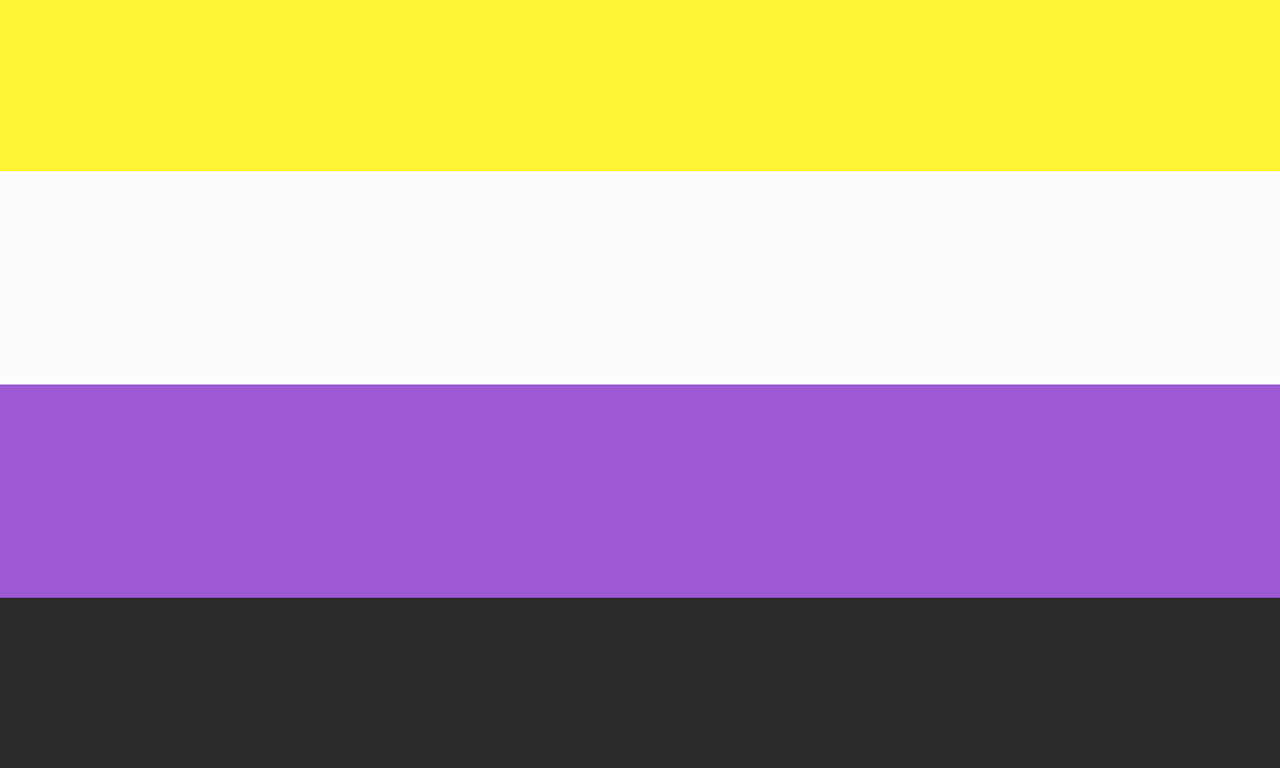
Flag Notes: Bored of the Asexual Pride Flag, and wanting to make it more lively, someone swapped the colours around and applied a liberal amount of day-glo paint, or a hi-viz hat.
Representatives: Singer Sam Smith, Poet Kae Tempest, and food writer & political activist Jack Monroe.
Demiboy and Demigirl Pride
Definition: two related identities which reflect that some people only partially identify with the gender binary (hence why there’s two of them). This may or may not be the gender they were assigned at birth, and in addition they may or may not identify partly as another gender. That said, it is most commonly represented as someone sitting between their birth gender and non-binary; indeed many demis also consider themselves to be non-binary.
Flag:
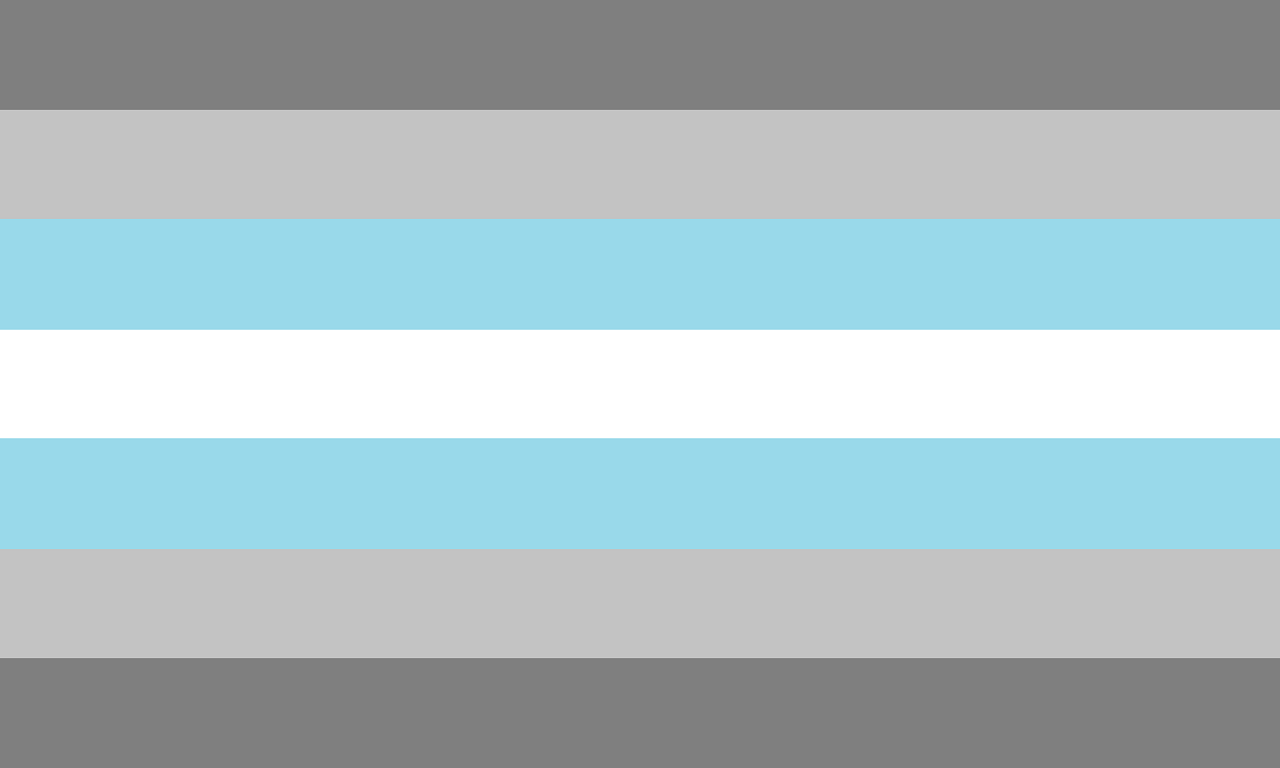
Flag Notes: Someone took the flag of Argentina, let the edges get a bit mucky, over-washed it with cheap washing powder so residual stains remained, then hung it out to dry in the hot sun for too long, letting it fade.
The demigirl flag is the same, except they used the flag of Austria.
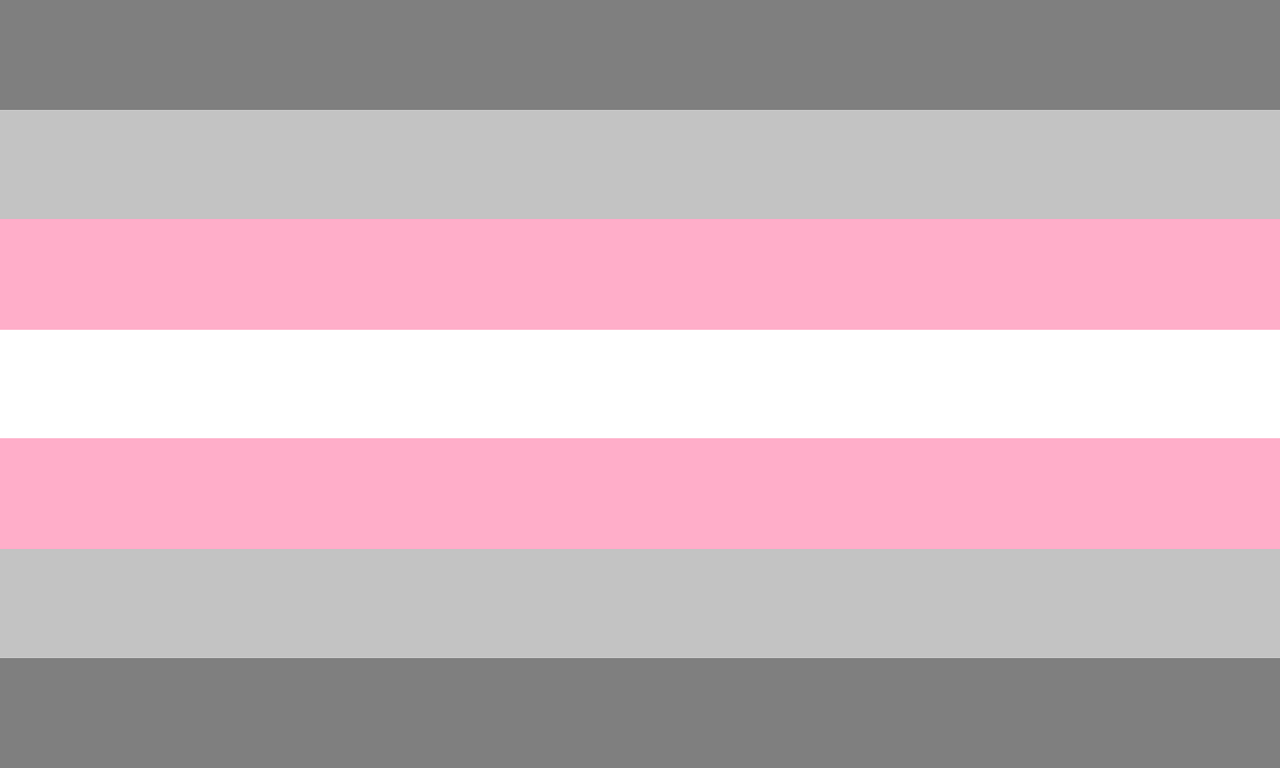
Representatives: There’s some overlap with other orientations, incl. Genderqueer, but people who have specifically identified as ‘demi’ include children’s fiction author Kacen Callender, clinical pyschologist Sand Chang, and writer/podcaster The Barefoot Backpacker.
Agender Pride
Definition: genderlessness. Sometimes rendered as ‘a lack of gender’. If non-binary is a spectrum of identities that sit between the gender binary, these people sit almost outside that spectrum, in the same way that asexuals sit ‘outside’ the sexual orientation spectrum. They tend to identify as ‘human’ or ‘a person’, rather than any definition that refers to gendered identity.
Flag:
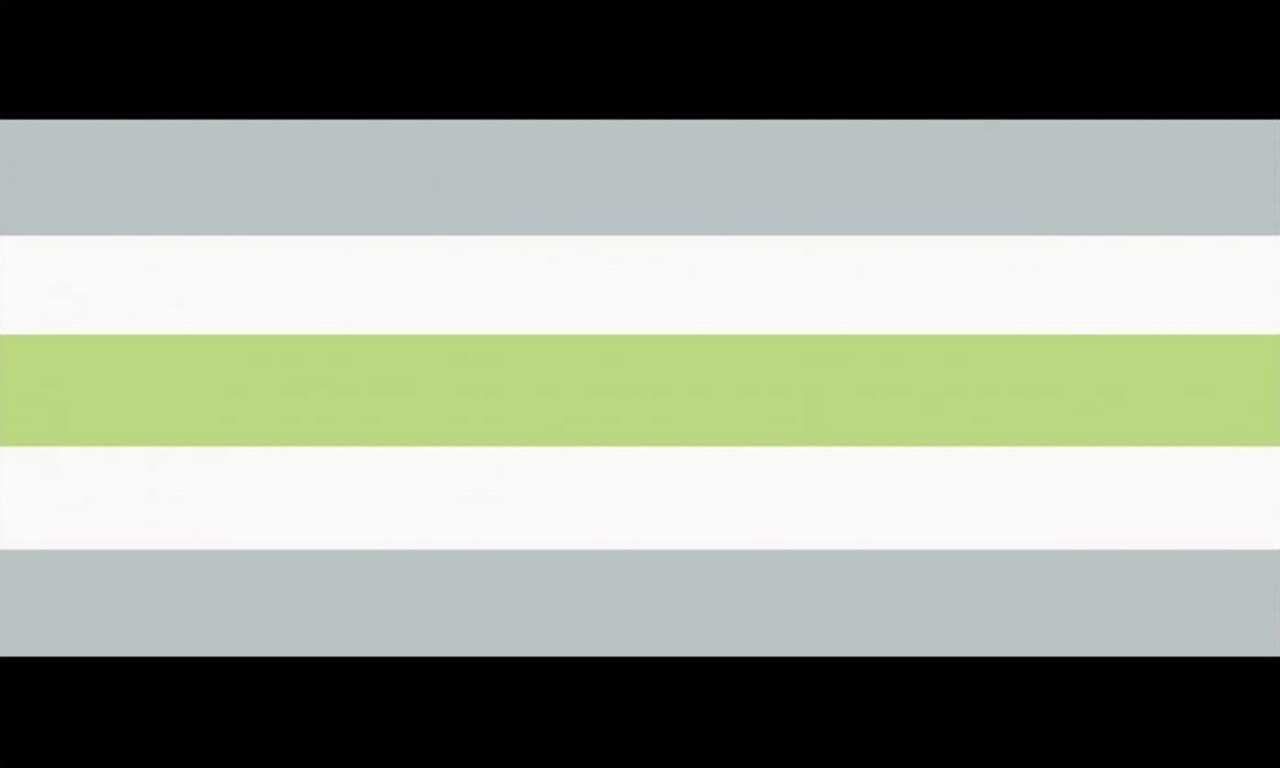
Flag Notes: My television is broken; look at all the lines where the display should be.
Representatives: Actor Ezra Miller, rapper Angel Haze, and author/activist sj Miller.
Intersex Pride
Definition: the ‘I’ in LGBTQIA+. Out of all the gender and sexual identity representations, this is the one that is a little unlike the others, as it’s just as much about physical/biological characteristics as mental ones. These are people born with certain variations that may make it more difficult to assign a gender at birth in the first place. They may have chromosomes or hormones that cross the binary gender divide, indeterminate genitalia, or other sex characteristics that make it harder for medical observers to assign them to a side. Very different to Transgender as that’s more about attitude; Intersex is more about actual body design/engineering.
Flag:

Flag Notes: Stripes? We ain’t got no stripes! We don’t need no stripes! I don’t have to show you any stinking stripes!
Representatives: author Hida Viloria, musician
Noetisexual Pride
Definition: I’m putting this in more because of the flag than anything else. It’s a specific sexual orientation identity, and one which few people know of, but I suspect more people experience than you might expect. It can be loosely described as ‘someone who needs an intellectual attraction to form a bond with someone’, but importantly that doesn’t mean they’re attracted to intelligence. Rather, it means someone who is only attracted to people who, to coin a phrase ‘are on their wavelength’, or who like the way that person ‘thinks’. An example might be someone who admires people who uses certain words, or who have a particular structure/way in kitchen duties, or with whom they share a political worldview.
Flag:
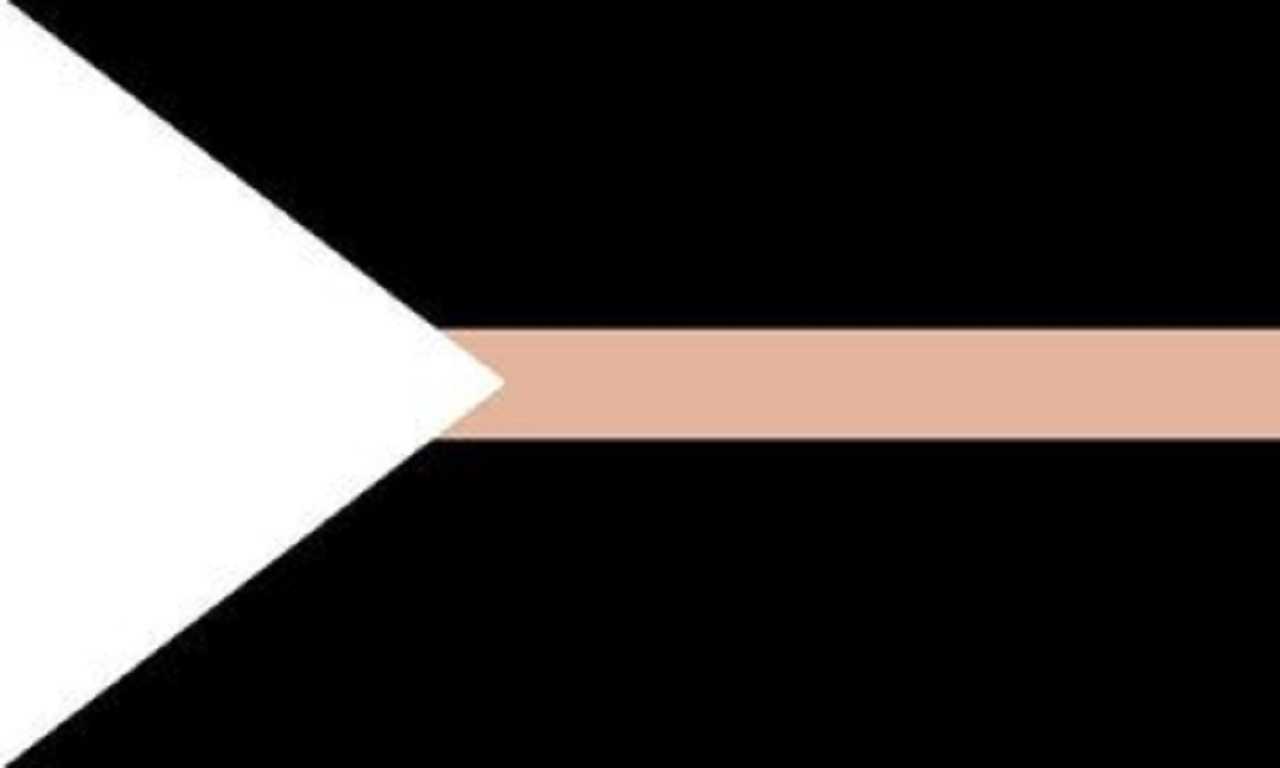
Flag Notes: If you “rotate it [one way] … it’s a big triangle with a beam of peach light shooting upwards into the night sky” according to ‘Soup’ (referenced above). If you rotate it the other way it looks like a two-tone shirt with a pinkish tie.
It is the second worst flag I’ve ever seen, and is only included here to make that observation.
Representatives: None known.
The City Flag of Magnitogorsk
Definition: A city in Russia, at the southern end of the Ural Mountains and just north of the border with Kazakhstan. It has a history of iron-ore mining.
Flag:
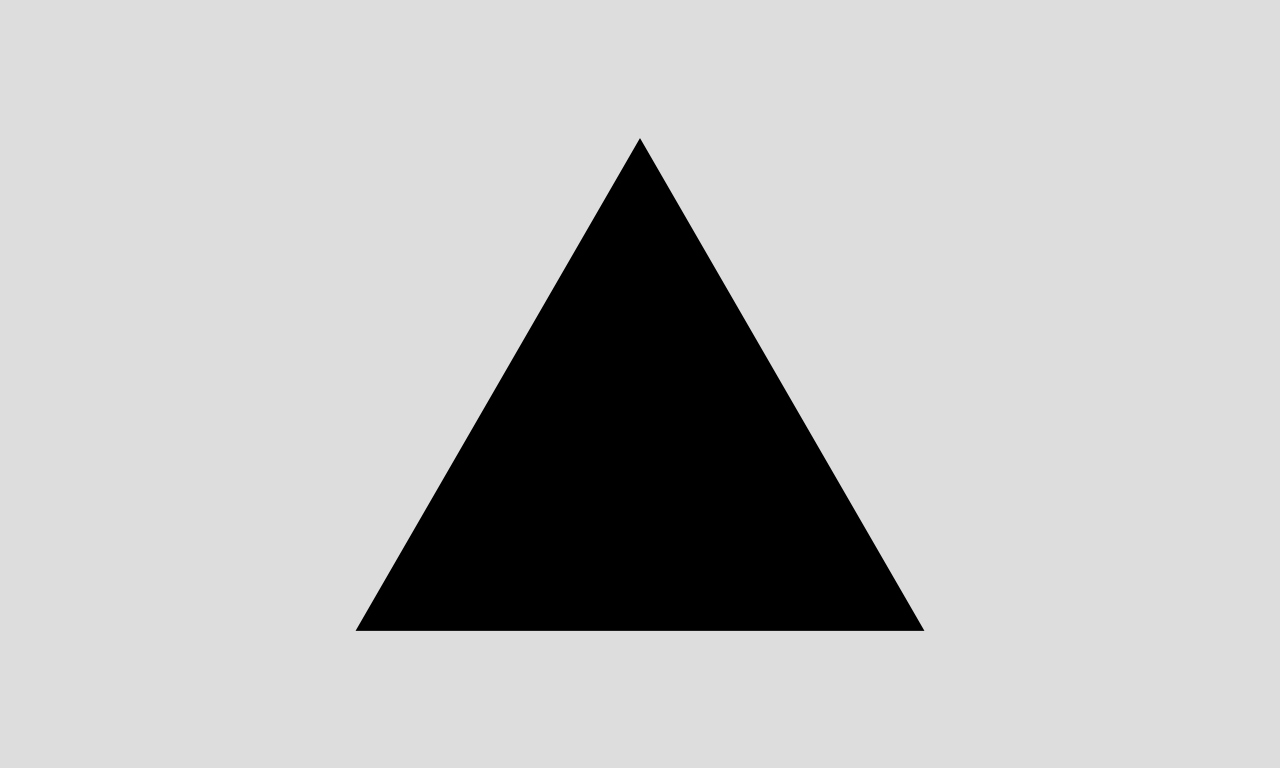
Flag Notes: The worst flag I have ever seen. It makes the Asexual Pride flag look like an explosion in a paint factory. Grey and black. Not really one to elicit pride, I don’t imagine. The black triangle is representative of the mountain from which the iron ore was mined. Flag included here for comparison purposes only.
Representatives: A couple of ice-hockey players, if you’re really interested.
Hope that helps next time you’re walking down a street and see a flag you don’t recognise, but feel sure it’s not a lesser-known country. And remember, identities are valid, even if the flags are dubious. This list, by the way, is in no way exhaustive; there are plenty of other identities and orientations people have. There’s just only so many flags you can analyse without seeing lines in front of your eyes. I talk a little about this too on my podcast episode about toxic masculinity and gender pride, where I also go into more detail about my own gender identity.